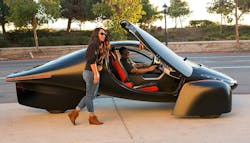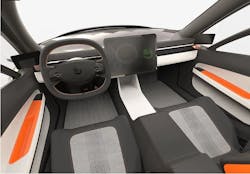Electric-Vehicle Underdogs
What you'll learn:
- Details about Aptera's EV three-wheeler.
- What's the company's financial situation?
- What happened to Elio Motors?
2020 seems to have marked the break-over point where the automotive industry finally ran out of excuses for why they couldn't build electric cars and started to electrify their fleets as if their lives depended on it (which they very well may). A good deal of credit goes to handful of leaders such as GM's CEO Mary Barra (also a seasoned engineer and self-avowed car nerd) for dragging their companies from cautious token electrification projects to the bold, bet-the-farm initiatives.
It's unlikely, however, that most automakers would have joined the electric stampede for another decade (if ever) without upstarts like Tesla, Rivian, and a handful of other innovative outliers making what seemed impossible a few years ago look inevitable today. Their unexpected successes pushed many big manufacturers into rethinking what's possible and inspired many consumers to rethink what we dream of owning. So it was a happy surprise last week when Aptera, one of my favorite upstarts, returned from the dead and once again appears to have at least a shot at making it to production.
For those of you unfamiliar with the Aptera, it's a three-wheeled two-seater with a streamlined carbon fiber body that looks more like an aircraft than a car and boasts an aerodynamic coefficient of 0.13. The result is an agile, efficient, and comfortable car that can drive up to 40 miles from the power soaked up by its rooftop solar cells on a sunny day.
Aptera says that that the car is so slippery that it draws only 100 Wh per mile traveled, about 20% to 40% of the average EV, enabling them to carry a proportionally smaller battery that yields significant savings in space, weight, and cost. This is one of the factors that allowed the company to set the cost of their base model, equipped with a battery that gives it a 250-mile range, at $25,000. Aptera says it will offer other models with a 400-mile range for $29,800, 600 miles for $34,600, and 1,000 miles for $44,900. Buyers also will have the choice of a 100-kW front-wheel-drive system or 150-kW all-wheel-drive powertrain.
What About the Quirky Design?
With over a decade of design refinements and several working prototypes under its belt, I'm pretty sure that Aptera can deliver the goods—at least from a technical standpoint. So the question remains will regular consumers be willing to plunk down $25K for one? Let's face it, the composite-bodied three-wheeler looks pretty strange and only seats two people (just like the ill-fated, unloved Smart Car). And I shudder to think about what a steep driveway entrance or the snow drifts we sometimes get here in New Jersey would do to its sleek, low-slung enclosed wheel fairings.
But when I look at the Aptera through an engineer's eyes, its quirky looks reveal a set of smart, focused, and very practical design criteria that shaped the vehicle to excel at its mission – carrying two people where they need to go, quickly and comfortably, and sustainably. And, as someone who's built and flown their own plane, I'm in love with the cabin, which has the precise, functional feel of a cockpit, with just enough styling to make it feel a bit like an X-Wing fighter.
That's why I’m rooting for the Aptera the way my friends from Chicago root for their beloved 'Sox. And, at $25K to $35K, I may even be able to buy one—if it ever makes it to production. So what are the chances of that happening?
Consider the fact that Aptera has already gone out of business once, not a good sign (actually, it's much more complicated than that, click here for details). I also don't quite understand how the company plans to turn the $4M it recently raised from a Series A funding round into the $500M to $1B it will take to tool up for production.
I assume at least some of it will be from leveraging the 7,000 orders they have on the books, worth an estimated $250M. Beyond that, though, the company hasn't provided a clue. Most of those orders have been secured by a $100 deposit, and I assume that Aptera's financial wizards will attempt to spin those strawman commitments into the Silicon Valley-style gold.
Aptera's murky finances have me puzzled and concerned, but I'm still hoping it all works out. It's mostly about the tech, but also because I have a soft spot for underdogs. Way back when Tesla was a weird little upstart, I developed a deep affection for the company after getting an insider's tour of its tiny first factory. I didn't know if they would succeed, but its Corvette-eating Roadsters were so audaciously cool that I had to root for them. I couldn't afford to buy one, but wish I'd had the sense to buy some stock back then.
Elio’s Three-Wheeler
A few years later, the same sentiments drove me to put $100 down on another oddball underdog vehicle. From its three-wheel configuration to its sleekly faired wheels, the Elio is eerily similar to the Aptera other than its tiny gasoline engine and tandem seating configuration.
Conceived as an ultra-low-cost ($8K), ultra-efficient commuter (80+MPG), the gas-powered Elio was intended to be a green vehicle that was fun to drive and everyone could afford. Besides falling in love with the design, Elio Motors' ongoing coverage of its acquisition and conversion of a defunct manufacturing plant in Louisiana made it seem like it had a reasonable chance for success. But, despite 65,000 orders and nearly $400M in funding, the company petered out in 2018, without ever delivering a single vehicle to its customers.
That last experience made me a little gun shy, so I'm holding off on a deposit for an Aptera until there's more evidence that it has a shot at carrying the ball across the goal line. But that's not keeping me from rooting for them, and some of the other promising underdogs who are challenging the norms of the automotive and aviation industries.
Comments? Questions? Thoughts about your favorite upstarts and underdogs you'd care to share?
Write me at [email protected]
About the Author
Lee Goldberg
Contributing Editor
Lee Goldberg is a self-identified “Recovering Engineer,” Maker/Hacker, Green-Tech Maven, Aviator, Gadfly, and Geek Dad. He spent the first 18 years of his career helping design microprocessors, embedded systems, renewable energy applications, and the occasional interplanetary spacecraft. After trading his ‘scope and soldering iron for a keyboard and a second career as a tech journalist, he’s spent the next two decades at several print and online engineering publications.
Lee’s current focus is power electronics, especially the technologies involved with energy efficiency, energy management, and renewable energy. This dovetails with his coverage of sustainable technologies and various environmental and social issues within the engineering community that he began in 1996. Lee also covers 3D printers, open-source hardware, and other Maker/Hacker technologies.
Lee holds a BSEE in Electrical Engineering from Thomas Edison College, and participated in a colloquium on technology, society, and the environment at Goddard College’s Institute for Social Ecology. His book, “Green Electronics/Green Bottom Line - A Commonsense Guide To Environmentally Responsible Engineering and Management,” was published by Newnes Press.
Lee, his wife Catherine, and his daughter Anwyn currently reside in the outskirts of Princeton N.J., where they masquerade as a typical suburban family.
Lee also writes the regular PowerBites series.




